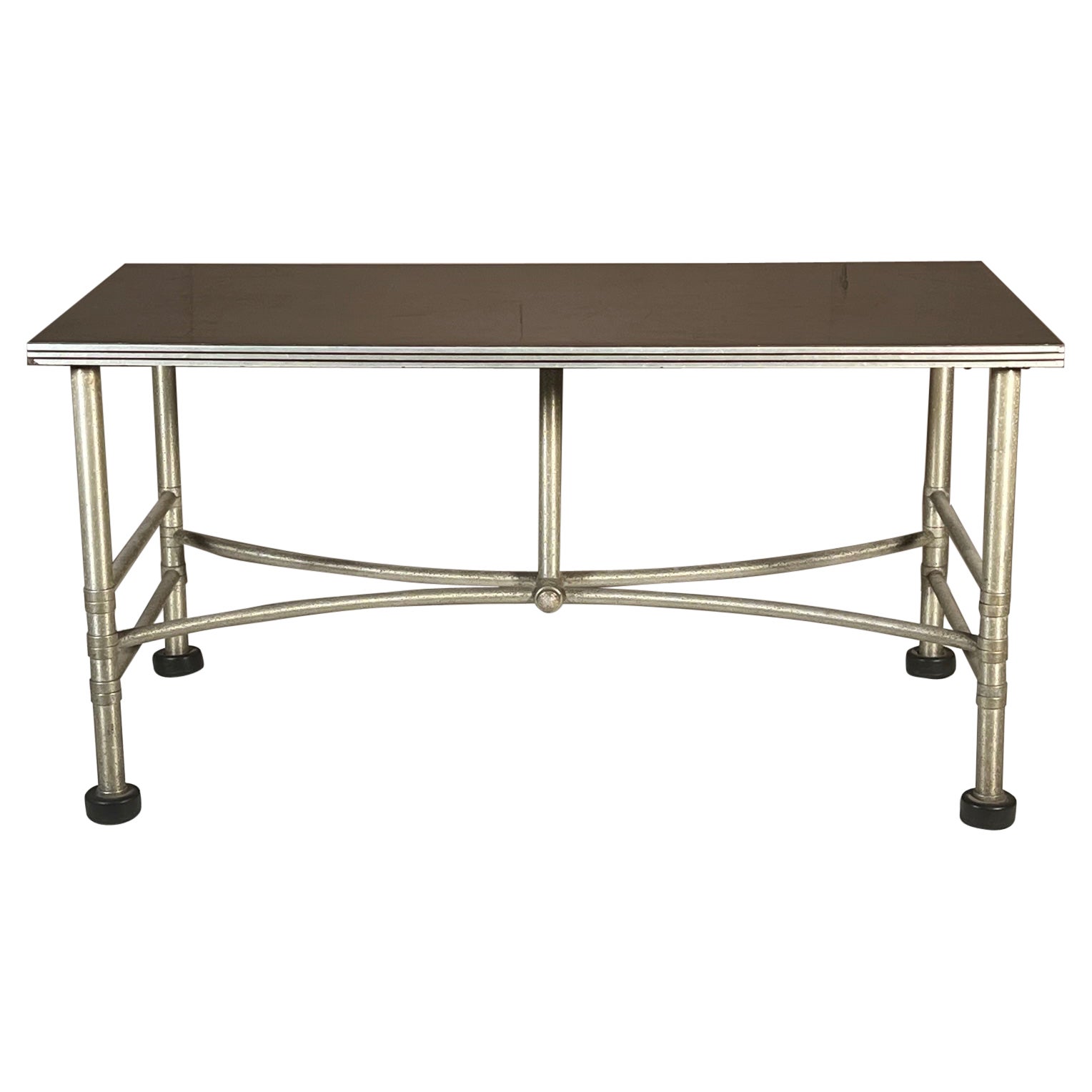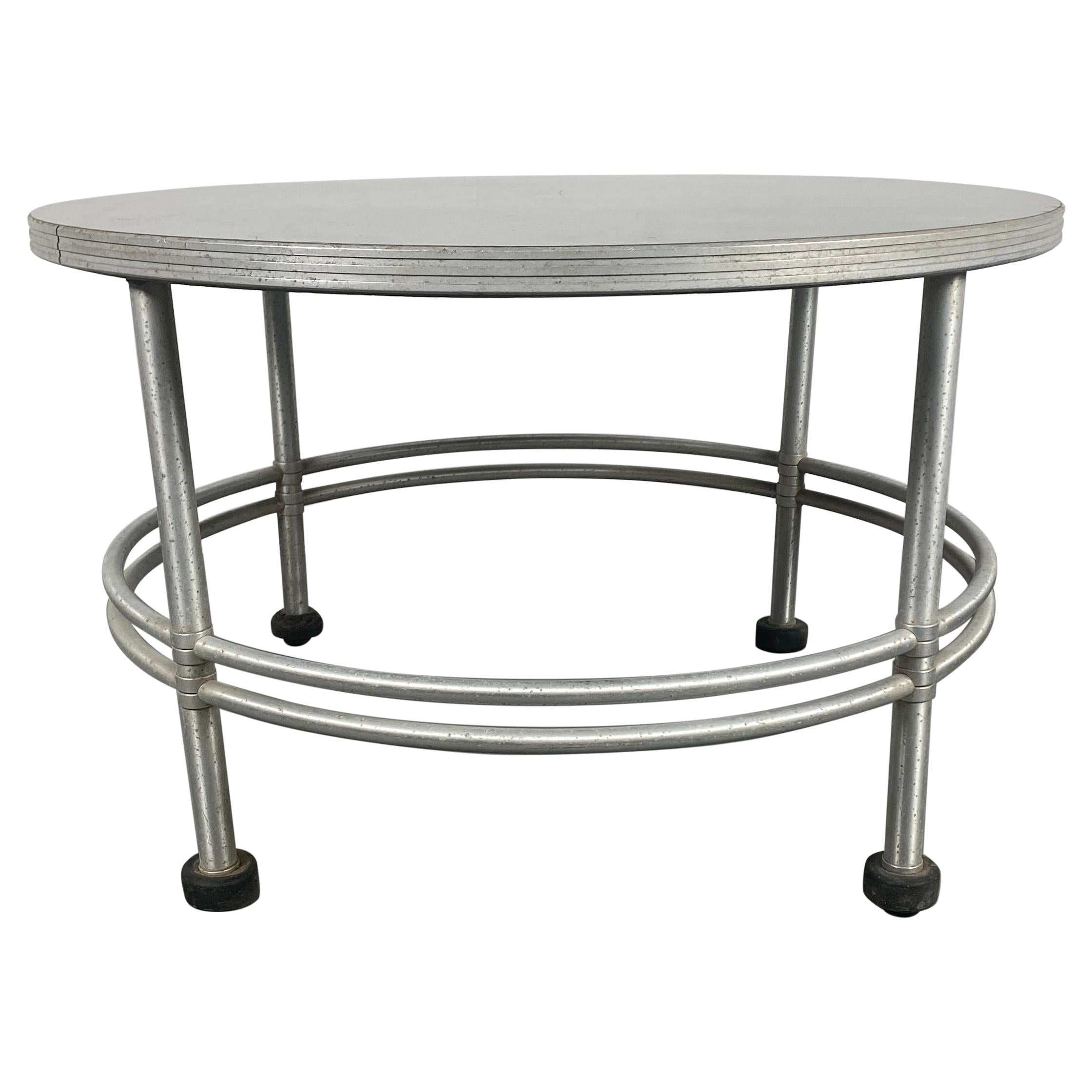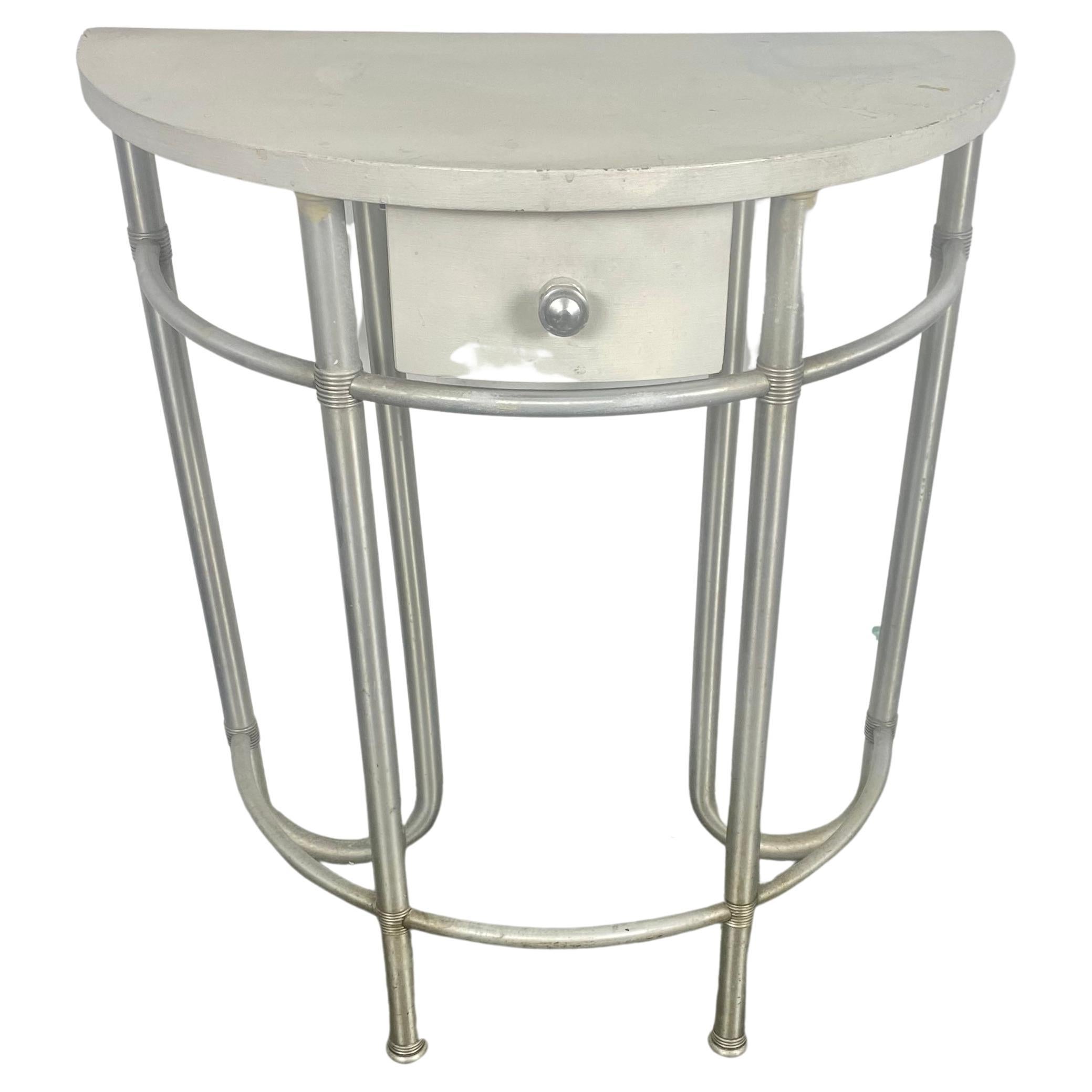Items Similar to Warren McArthur Streamline Modern Aluminum Black Coffee Table Model 1559-s 1930s
Want more images or videos?
Request additional images or videos from the seller
1 of 12
Warren McArthur Streamline Modern Aluminum Black Coffee Table Model 1559-s 1930s
About the Item
Warren McArthur
Coffee table, model 1559-s
Warren McArthur Corporation
USA, c. 1930
enameled aluminum, laminate
18½ h × 30 dia in (47 × 76 cm)
literature: Warren McArthur Corporation, Donnelly, pg. 50
Warren McArthur Jr. was an innovator in Machine Age/ Art Deco furniture design.
McArthur moved from Chicago to Los Angeles in 1929 to pursue metal furniture manufacturing; he founded the Warren McArthur Corporation there in 1930. His furniture designs while unique were true to the Machine Age aesthetic. Machine Age design emphasized sleek forms inspired by automobiles, locomotives and airplanes. These objects were symbols of progress and modernity to the American consumer and industrial designers began constructing furniture in streamlined designs from steel, chrome and aluminum.
Prior to the 1933 Chicago World’s Fair, known as the “Century of Progress Exhibition.” The fair’s tagline, “See America Streamlined,” and the abundance of metal furniture and home goods exhibited finally presented the concept of utilizing metal designs in the typical American household. The Museum of Modern Art followed suit in subsequent years with exhibitions like "Machine Art," (1934), and "Bauhaus 1919-1928" (1938), further exposing the American public to this design style.
The Warren McArthur Corporation moved manufacturing to Rome, New York in 1933, just as metal furniture was gaining popularity; the company’s products were sold out of a showroom in New York City on Park Avenue. As a manufacturer, McArthur filed numerous patent designs which he utilized in advertisements to exhibit the innovations he developed. The company also proudly printed patent numbers on furniture labels. This demonstrated to the customer that they were purchasing unique, scientifically designed, and thus inherently modern, furniture.
For both durability and comfort, McArthur’s tubular aluminum furnishings were constructed with an internal tension rod within the aluminum frame. This construction provided a slight ‘give’ which was believed to be a sign of quality and provide a higher level of comfort in chairs. McArthur’s innovative products achieved “maximum strength with a minimum of weight, while also permitting the attainment of a desirable attractiveness in appearance.” The internal rods are the backbone of any McArthur furniture frame - the exteriors composed of multiple pieces of tubular aluminum, held together inside by the rods and outside by the joinery.
The structural joints were another unique aspect of McArthur furnishings, elucidated in the same patent. Ever concerned with aesthetics, McArthur developed joinery that would not detract from his designs. The joints allowed for easy disassembly and reassembly because they did not use small screws, nails or other pieces that could be misplaced. In essence, the joints are composed of internal washers that affix the small portions of aluminum tube together over the internal rods. These interior parts are held together on the exterior by smooth or notched aluminum braces.
With the outbreak of World War II, aluminum in the United States was prohibited for private use. McArthur applied his talents to the war effort and designed aircraft seating for the Air Force and Navy, utilizing his expertise with the material. Unfortunately, after the war Machine Age design had fallen out of style and the Warren McArthur Corporation eventually closed shop in 1948.
Literature:
Edwards, Clive. "Aluminium Furniture, 1886-1986: The Changing Applications and Reception of a Modern Material." Journal of Design History 14, no. 3 (2001): 207-25.
Kirkham, Pat and Susan Weber. History of Design: Decorative Arts and Material Culture, 1400-2000. (New York: The Bard Graduate Center: Decorative Arts, Design History, Material Culture, 2013)
"Modern Solutions." Art Institute of Chicago Museum Studies 27, no. 2 (2001): 47-110.
Moonan, Wendy. "ANTIQUES; Rediscovered: Early Master of Metal." The New York Times, August 27, 1999, Arts sec.
Wilson, Richard Guy, et al. The Machine Age In America: 1918 - 1941. Japan: Times Mirror Books, 1986.
Warren McArthur Furniture Ltd. “Furniture”. 1933: n. pag. Google Patents. Accessed February 2, 2017.
- Creator:Warren McArthur Corporation (Maker),Warren McArthur (Designer)
- Dimensions:Height: 18 in (45.72 cm)Diameter: 31 in (78.74 cm)
- Style:Art Deco (Of the Period)
- Materials and Techniques:
- Place of Origin:
- Period:
- Date of Manufacture:1930
- Condition:Wear consistent with age and use. Minor fading.
- Seller Location:Brooklyn, NY
- Reference Number:1stDibs: LU4190327585702
About the Seller
5.0
Platinum Seller
These expertly vetted sellers are 1stDibs' most experienced sellers and are rated highest by our customers.
Established in 2017
1stDibs seller since 2018
591 sales on 1stDibs
Typical response time: 1 hour
- ShippingRetrieving quote...Ships From: Brooklyn, NY
- Return PolicyA return for this item may be initiated within 1 day of delivery.
More From This SellerView All
- Warren McArthur Streamline Modern Aluminum Chair, Art Deco, 1930s, USABy Warren McArthur Corporation, Warren McArthurLocated in Brooklyn, NYWarren McArthur chair, Warren McArthur Corporation, aluminum, leather, copper, rubber, USA, 1930s. Measures: 33½ H × 17 W × 21 D in Provenance: Collection of Stuart Parr Private Collection Warren McArthur Jr. was an innovator in Machine Age/ Art Deco furniture design. McArthur moved from Chicago to Los Angeles in 1929 to pursue metal furniture manufacturing; . he founded the Warren McArthur Corporation there in 1930. His furniture designs while unique were true to the Machine Age aesthetic. Machine Age design emphasized sleek forms inspired by automobiles, locomotives and airplanes. These objects were symbols of progress and modernity to the American consumer and industrial designers began constructing furniture in streamlined designs from steel, chrome and aluminum. Prior to the 1933 Chicago World’s Fair, known as the “Century of Progress Exhibition.” The fair’s tagline, “See America Streamlined,” and the abundance of metal furniture and home goods exhibited finally presented the concept of utilizing metal designs in the typical American household. The Museum of Modern Art followed suit in subsequent years with exhibitions like "Machine Art," (1934), and "Bauhaus 1919-1928" (1938), further exposing the American public to this design style. The Warren McArthur Corporation moved manufacturing to Rome, New York in 1933, just as metal furniture was gaining popularity; the company’s products were sold out of a showroom in New York City on Park Avenue. As a manufacturer, McArthur filed numerous patent designs which he utilized in advertisements to exhibit the innovations he developed. The company also proudly printed patent numbers on furniture...Category
Vintage 1930s American Side Chairs
MaterialsAluminum
- Tommi Parzinger, Green Leather Occasional Table, Model No. 3303By Tommi Parzinger, Charak Furniture CompanyLocated in Brooklyn, NYTommi Parzinger green leather occasional table, model no. 3303, ca. 1955 Ebonized wood, embossed leather. Manufactured by Charak, USA. Measures: 26" H ...Category
Mid-20th Century American Mid-Century Modern Side Tables
MaterialsLeather, Wood
- Ebonized Mahogany Tri-Level Round Coffee Table, Paul Laszlo, Brown Saltman LABy Brown Saltman, Paul LaszloLocated in Brooklyn, NYEbonized mahogany tri-level coffee table, attributed to Paul Laszlo, Brown Saltman Los Angeles, c. 1952. A pioneering force in the evolution of California Modern, Paul László imbued the more rigid European modernism with plusher comfort and more sumptuous flair. Laszlo began his career in Stuttgart, an epicenter of modern design prior to WWII and gained international recognition for his sumptuous, sensual brand of modernism. His early fans included Salvador Dali and George Nelson. Laszlo accepted a professorship in the US as a means of fleeing the Nazis (Two of his siblings and both his parents would die in the Holocaust). From New York, László drove cross-country to California, where he opened an office in Beverly Hills. Despite speaking hardly any English, his reputation preceded him, and he soon started receiving commissions, including remodeling and refurnishing Bullock’s on Wilshire Boulevard, the premier department store in Los Angeles. By the late 1930s László had become designer of choice to the Hollywood elite. Laszlo combined sleek geometric lines and rich woods together with novel materials and textures (ex. lucite and faux weaving), sometimes adding more traditional flourishes such as floral fabrics. His bold use of color was also a major attraction. He opened his new design studio on North Rodeo Drive in 1941, which he would maintain for over 25 years. In 1946, László furnished the residence of Rene Williams in Beverly Hills with designs that have become recognizable classics, such as the Paddle Armchairs, named for their flat, wide armrests. All the pieces from the grouping have clean, elegant lines that draw from Viennese Modern...Category
Mid-20th Century American Mid-Century Modern Coffee and Cocktail Tables
MaterialsMahogany
- Minimal Vintage Green Velvet Upholstered Occasional Table, SilkLocated in Brooklyn, NYMinimal vintage green velvet upholstered occasional table set, silk umber, 1960s. Silk velvet in an arresting hue that lies between olive gree...Category
Mid-20th Century American Minimalist Coffee and Cocktail Tables
MaterialsSilk, Velvet
- Minimal Vintage Green Silk Velvet Upholstered Occasional TableLocated in Brooklyn, NYMinimal vintage green velvet upholstered occasional table set, silk umber, 1960s. Silk velvet in an arresting hue that lies between olive green, burnt ...Category
Mid-20th Century American Minimalist Coffee and Cocktail Tables
MaterialsSilk, Velvet
- Minimal Vintage Green Velvet Upholstered Occasional Table Set, SilkLocated in Brooklyn, NYMinimal vintage green velvet upholstered occasional table set, silk umber, 1960s. Silk velvet in an arresting hue that lies between olive gree...Category
Mid-20th Century American Minimalist Coffee and Cocktail Tables
MaterialsSilk, Velvet
You May Also Like
- Warren McArthur Coffee Table ca' 1930'sBy Warren McArthurLocated in St.Petersburg, FLUnusual Warren McArthur coffee table with architectural, machine age base and original formica black top. Signed underneath.Category
Vintage 1930s American Machine Age Tables
MaterialsAluminum
- Rare Transitional Side Table/Etagere by Warren McArthurBy Warren McArthurLocated in Stamford, CTA ebonized and polished Aluminum side table by Warren McArthur. This side table is almost certainly from 1929, showing the prevalence of the triangle in McArthurs work around the tim...Category
Vintage 1920s American Art Deco Side Tables
MaterialsAluminum
- Warren McArthur Side Table with Patinated TopBy Warren McArthurLocated in Dallas, TXWarren McArthur aluminum table with patinated wooden top.Category
Vintage 1930s Side Tables
MaterialsAluminum
- Warren McArthur TableBy Warren McArthurLocated in West Palm Beach, FLWarren McArthur Table Aluminum,Black Glass and rubber Signed with decal LabelCategory
20th Century American End Tables
MaterialsAluminum
- Machine Age / American Art Deco Warren McArthur Aluminum Cocktail TableBy Warren McArthur CorporationLocated in Buffalo, NYMachine Age / American Art Deco Warren McArthur cocktail table, c.1935, Classic design, aluminum base, black laminate top, aluminum banding. R...Category
Vintage 1930s American Art Deco Coffee and Cocktail Tables
MaterialsAluminum
- Rare Warren McArthur Console / Hall Table, Art Deco, Machine Age, 1930'sBy Warren McArthur Corporation, Warren McArthurLocated in Buffalo, NYExtremely rare demilune console table designed by Warren McArthur. Amazing design, proportion, table has been re-painted (at some point) Retains remnants of original label, Also orig...Category
Vintage 1930s American Art Deco Console Tables
MaterialsAluminum
Recently Viewed
View AllMore Ways To Browse
Small Black Modern Coffee Table
Tubular Black Table
Modern Art Deco Coffe Tables
Japanese Modern Coffee Table
Chrome Black Coffee Table
Black And Chrome Coffee Table
Black Deco Coffee Table
Art Deco Black Coffee Table
Black Metal C Table
Streamline Table
Chrome Black Cocktail Table
Used Coffee Shop Furniture
Mirror Black Coffee Table
Black Laminate Coffee Table
Small Modern C Table
18 C Table
50s Black Table
Coffee Shop Vintage





